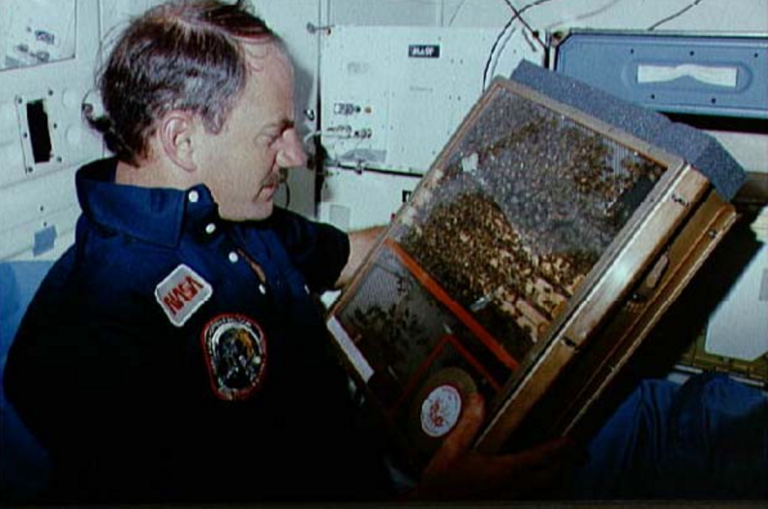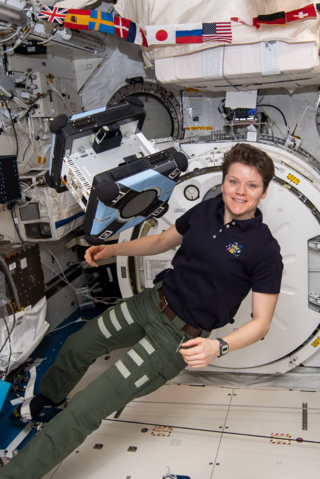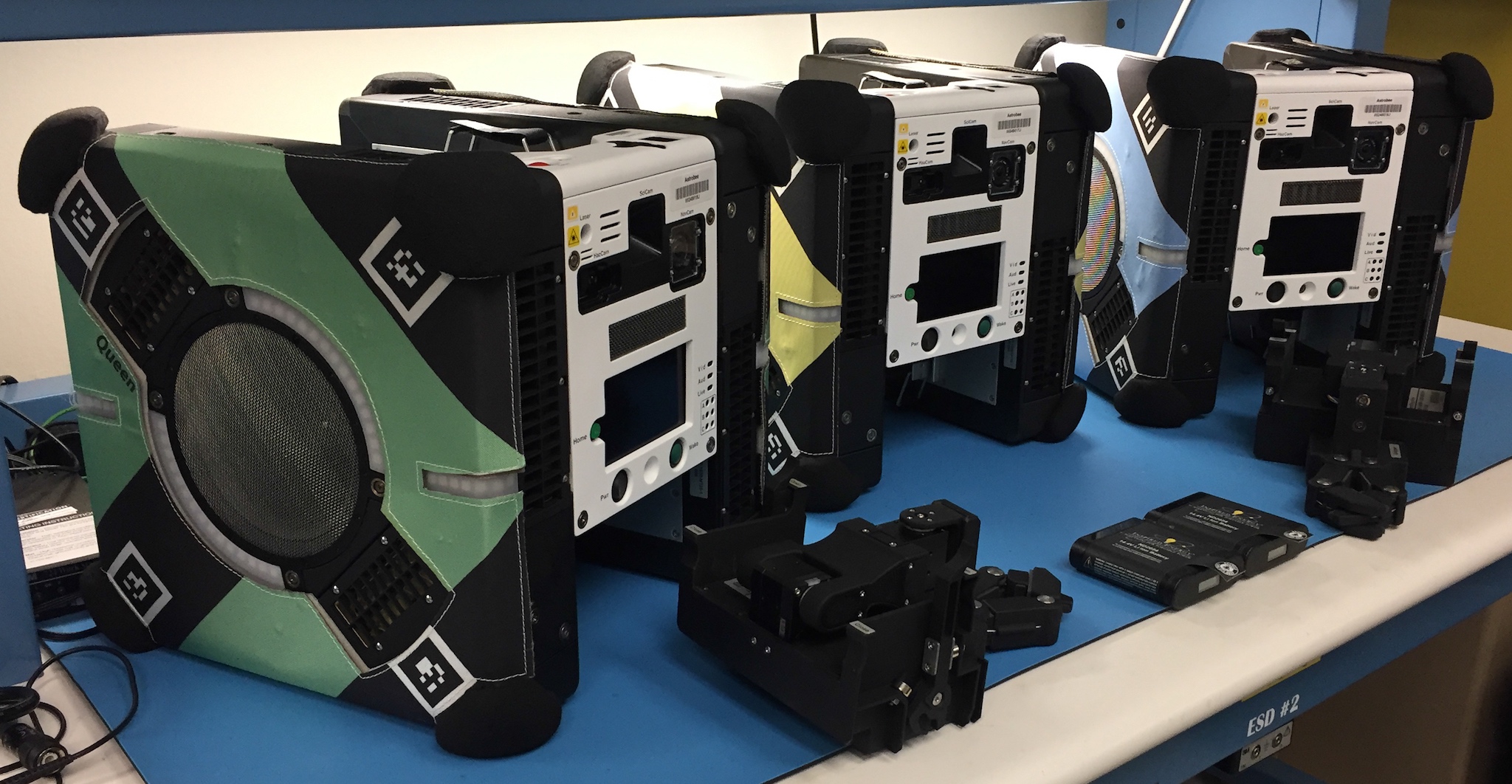In fact, it is amazing enough that bees have populated the entire world with the exception of Antarctica (and the parts of China where they were successfully exterminated). No matter how warm or cold it is, wherever there are flowers, there are specialized bee species that ensure the local pollination of the plants. There are even bees in areas in the icy Arctic and the hostile Sahara.
But a place where you would definitely not expect the bees is space. And yet the little insects made it there too. Not on their own, of course, they owe their space voyages to curious scientists. But in purely quantitative terms, the bees are superior to man when it comes to space travel: 6815 of them have made it into space (or rather, into orbit). So far there have been more bees in space than people.
But what reason is there to send the hard-working little pollinators so far away from their natural environment with all the blooming plants? And what do the bees actually say about it?
So far there have been 3 space missions in which bees have been sent into space. The first of them was in 1982. On this first mission, 14 individual bees were put into orbit to study how weightlessness affects their ability to fly and their behavior. Such experiments have already been tested with other insects. The result: After a few uncontrolled flights due to the weightlessness, the insects gave up their flight attempts completely and from then on only moved crawling through their dwellings. With the very intelligent bees, one hoped for a different result. Unfortunately, the 14 individual bees, detached from their natural way of life as a colony, were not really capable of surviving and the experiment did not produce any new results.
As a result, two new bee experiments were brought to the space station in 1984 with the Challenger. Here, two special space-suitable beehives (bee enclosure modules, BEM for short) including honeycombs, and each with 3400 bees (including a queen bee) were sent into space. These were actually viable mini bee colonies. The planned experiments could now be carried out with real bee colonies. In addition to the flight behavior in weightlessness, one wanted to study the honeycomb construction behavior in weightlessness.

Photo: NASA
These bees, too, initially only made very uncontrolled flights in weightlessness and at the beginning constantly bumped against the walls of their bee space travel modules. However, because honey bees are extremely adaptive, they quickly developed new strategies for locomotion in the new environment. After just seven days, the bees were able to fly without problems even in weightlessness. This distinguishes them from all other insects that were tested in weightlessness. The queen bee also normally laid eggs in the cells of the comb. What is even more astonishing: The bees were even able to build their honeycomb structure without any problems despite the lack of gravity. This is a particularly astonishing result since the common doctrine is that the bees orient the alignment of their honeycomb structure on the basis of gravity. The honeycombs always hang vertically facing the ground. Even in zero gravity, all honeycombs were built in a uniform “downwards” direction.

Photo: NASA
Overall, this research shows that bees hold many more secrets than we previously believed and that they are extraordinarily adaptable.
I wonder what the astronauts thought of these experiments. I can imagine that floating through space in a confined space together with possibly 6,800 bees in an isolated capsule is not pleasant for everyone. But I’m sure NASA has done everything possible here to develop escape-proof space beehives. After all, this was the most expensive bee experiment in history to date.
Anyone who has now done the math in their head will say: “But that was only 6814 bees. There’s still one missing.” And that’s exactly right. The last bee was a lone fighter and was recently sent into space. However, it is not an involuntary passenger who accidentally sat in the space capsule when taking off, but an art project of the Federal Art Hall in Germany. There are bess living in several beehives on the roof of the Federal Art Hall. For a special exhibition called “Outerspace”, one of these bees was enclosed in synthetic resin and shot into space on May 28, 2014, together with the astronaut Alexander Gerst. After this poor bee, degraded to an art object, had completed its excursion into space, it was brought back to earth again and has since been admired in the exhibition. So you could say that she is the most famous of the space bees, although, unlike the other 6814 bees, she was not even there alive.
Did the bees also produce cosmic honey?
Of course, the space bees had no way of collecting nectar, and therefore producing a special space honey on the space station was not a possible outcome. They instead were fed with regular sugar solution. However, there is an interesting anecdote to report from the episode “The Sting”, Episode 12, Season 4 of the animated series “Futurama”. In this fictional story, the crew of the space courier Planet Express is supposed to collect space honey from gigantic bees living in space. As appropriate for such extraordinary honey, this honey has very special properties: 1 spoon has a calming effect, 2 spoons cause deep sleep. However, a warning is given against consuming more than 2 spoons. 3 spoons are supposed to induce sleep that is so deep that you never wake up from it again. So it is clearly a psychoactive honey. Fittingly, the whole plot revolves around experiences that the protagonist Leela experiences in a delirium induced by the space bees. The whole thing may be a purely fictional story, but when it comes to cool psychoactive honey, an intoxicating space honey clearly takes the forefront.
Astrobees: The autonomous bee robots on the ISS

Photo: NASA
But the futuristic story continues in a no less exciting way in our real world: under the name Astrobees, 3 autonomous, intelligent, flying robots have been operating on the ISS for some time. These square cubes are intended to support the astronauts in their daily tasks. They owe their name to the humming noise they make when they float through weightlessness. To prevent collisions between humans and machines in tight spaces, the small robots are equipped with flashing lights that indicate their destination during flight. Since intelligent, humming space bee robots that fly independently through the space station seems a bit spooky not only to me, the models were later equipped with an animated pair of eyes, which is shown on the display on the front. A facial expression is now simulated in a comic manner, which is intended to loosen up the situation between humans and robots. Since another task of these little robots is to research the interactions between humans and robots in space, this is a suitable feature. The three small boxes look like flying construction site radios, but they are state-of-the-art, super expensive devices that could also come straight from a science fiction film. By the way, they go by the names Bumble, Honey, and Queen. After the docking station, which the robots fly to independently for charging purposes, was brought to the space station and installed there, the first two robots Bumble & Honey reached their place of use on April 17, 2019. On July 25, 2019, the third robot, which goes by the name of Queen, followed with another cargo mission.
These three futuristic space robots are now also available for free research. Anyone with the necessary amounts of cash can now book a research slot directly from NASA and carry out their own research with the space bee robots on the ISS. The future is now. I think it’s great that the first autonomous space robots, which are in no way inferior to the models from science fiction films, are named after the bees.

Photo: NASA
Text: Fabian Kalis
Image source: all images from the NASA image archive, http://www.nasa.gov